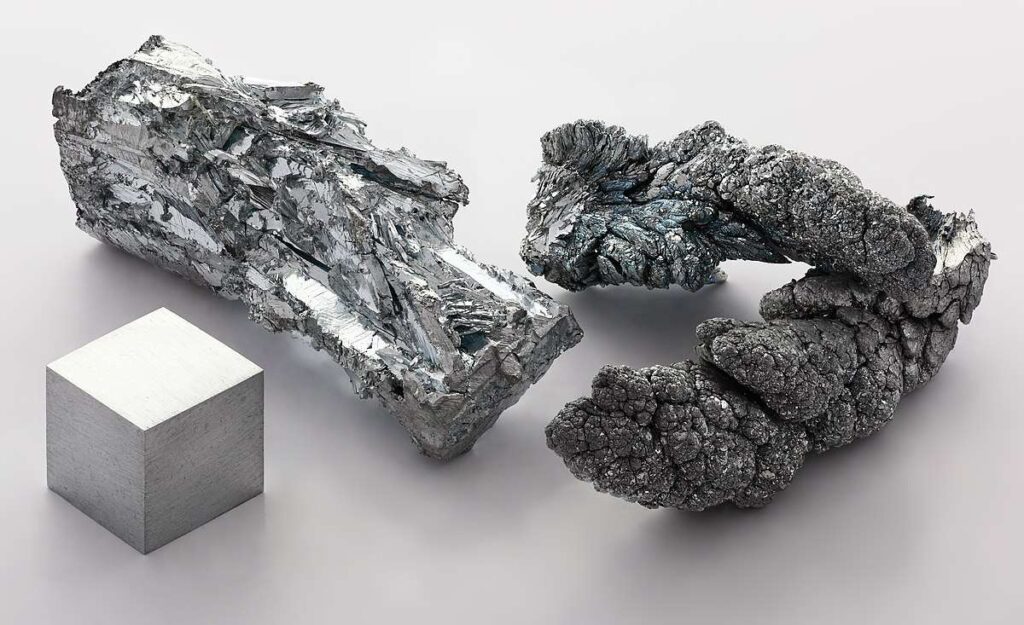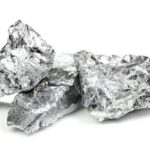Zinc (symbol Zn), in commerce also spelter, is a metallic chemical element. It has atomic number 30. It is the first element of group 12 of the periodic table. In some respects zinc is chemically similar to magnesium: its ion is of similar size and its only common oxidation state is
+2. Zinc is the 24th most abundant element in the Earth’s crust and has five stable isotopes. The most common zinc ore is sphalerite (zinc blende), a zinc sulfide mineral. The largest mineable amounts are found in Australia, Asia, and the United States. Zinc production includes froth flotation of the ore, roasting, and final extraction using electricity (electrowinning).
Brass, which is an alloy of copper and zinc, has been used since at least the 10th century BC in Judea and by the 7th century BC in Ancient Greece. Zinc metal was not produced on a large scale until the 12th century in India and was unknown to Europe until the end of the 16th century. The mines of Rajasthan have given definite evidence of zinc production going back to
6th century BC. To date, the oldest evidence of pure zinc comes from Zawar, in Rajasthan, as early as the 9th century AD when a distillation process was employed to make pure zinc. Alchemists burned zinc in air to form what they called “philosopher’s wool” or “white snow”.
Applications
Major applications of zinc include
• Galvanizing (55%)
• Alloys (21%)
• Brass and bronze (16%)
• Miscellaneous (8%)
The metal is most commonly used as an anti-corrosion agent. Galvanization, which is the coating of iron or steel to protect the metals against corrosion, is the most familiar form of using zinc in this way. In 2009 in the United States, 55% or 893 thousand tonnes of the zinc metal was used for galvanization.
Zinc is more reactive than iron or steel and thus will attract almost all local oxidation until it completely corrodes away. A protective surface layer of oxide and carbonate forms as the zinc corrodes. This protection lasts even after the zinc layer is scratched but degrades through time as
the zinc corrodes away. The zinc is applied electrochemically or as molten zinc by hot-dip galvanizing or spraying. Galvanization is used on chain-link fencing, guard rails, suspension bridges, light posts, metal roofs, heat exchangers, and car bodies.
The relative reactivity of zinc and its ability to attract oxidation to itself makes it an efficient sacrificial anode in catholic protection (CP). For example, cathodic protection of a buried pipeline can be achieved by connecting anodes made from zinc to the pipe. Zinc acts as the anode (negative terminus) by slowly corroding away as it passes electric current to the steel pipeline. Zinc is also used to catholically protect metals that are exposed to sea water from corrosion. A zinc disc attached to a ship’s iron rudder will slowly corrode while the rudder stays unattacked. Other similar uses include a plug of zinc attached to a propeller or the metal protective guard for the keel of the ship.
With a standard electrode potential (SEP) of −0.76 volts, zinc is used as an anode material for batteries. (More reactive lithium (SEP −3.04 V) is used for anodes in lithium batteries ). Powdered zinc is used in this way in alkaline batteries and sheets of zinc metal form the cases for and act as anodes in zinc–carbon batteries.[98][99] Zinc is used as the anode or fuel of the zinc- air battery/fuel cell. The zinc-cerium redox flow battery also relies on a zinc-based negative half- cell.
Alloys
A widely used alloy which contains zinc is brass, in which copper is alloyed with anywhere from
3% to 45% zinc, depending upon the type of brass. Brass is generally more ductile and stronger than copper and has superior corrosion resistance.These properties make it useful in communication equipment, hardware, musical instruments, and water valves.
Other widely used alloys that contain zinc include nickel silver, typewriter metal, soft and aluminium solder, and commercial bronze. Zinc is also used in contemporary pipe organs as a substitute for the traditional lead/tin alloy in pipes.[104] Alloys of 85–88% zinc, 4–10% copper, and 2–8% aluminium find limited use in certain types of machine bearings. Zinc is the primary metal used in making American one cent coins since 1982.The zinc core is coated with a thin layer of copper to give the impression of a copper coin. In 1994, 33,200 tonnes (36,600 short tons) of zinc were used to produce 13.6 billion pennies in the United States. Alloys of primarily
zinc with small amounts of copper, aluminium, and magnesium are useful in die casting as well as spin casting, especially in the automotive, electrical, and hardware industries. These alloys are marketed under the name Zamak. An example of this is zinc aluminium. The low melting point together with the low viscosity of the alloy makes the production of small and intricate shapes possible. The low working temperature leads to rapid cooling of the cast products and therefore fast assembly is possible. Another alloy, marketed under the brand name Prestal, contains 78% zinc and 22% aluminium and is reported to be nearly as strong as steel but as malleable as plastic. This superplasticity of the alloy allows it to be molded using die casts made of ceramics and cement.
Similar alloys with the addition of a small amount of lead can be cold-rolled into sheets. An alloy of 96% zinc and 4% aluminium is used to make stamping dies for low production run applications for which ferrous metal dies would be too expensiveIn building facades, roofs or other applications in which zinc is used as sheet metal and for methods such as deep drawing, roll forming or bending, zinc alloys with titanium and copper are usedUnalloyed zinc is too brittle for these kinds of manufacturing processes.
As a dense, inexpensive, easily worked material, zinc is used as a lead replacement. In the wake of lead concerns, zinc appears in weights for various applications ranging from fishing to tire balances and flywheels.
Cadmium zinc telluride (CZT) is a semi conductive alloy that can be divided into an array of small sensing devices. These devices are similar to an integrated circuit and can detect the energy of incoming gamma ray photons. When placed behind an absorbing mask, the CZT sensor array can also be used to determine the direction of the rays.
Other industrial uses
Zinc oxide is used as a white pigment in paints. Roughly one quarter of all zinc output in the United States (2009), is consumed in the form of zinc compounds; a variety of which are used industrially. Zinc oxide is widely used as a white pigment in paints, and as a catalyst in the manufacture of rubber. It is also used as a heat disperser for the rubber and acts to protect its polymers from ultraviolet radiation (the same UV protection is conferred to plastics containing zinc oxide) The semiconductor properties of zinc oxide make it useful invaristors and
photocopying products. The zinc zinc-oxide cycle is a two step thermochemical process based on zinc and zinc oxide for hydrogen production.
Zinc chloride is often added to lumber as a fire retardant and can be used as a wood preservative. It is also used to make other chemicals.
Crystals of ZnS are used in lasers that operate in the mid-infrared part of the spectrum. Zinc sulfate is a chemical in dyes and pigments. Zinc pyrithione is used in antifouling paints.
Zinc powder is sometimes used as a propellant in model rockets. When a compressed mixture of
70% zinc and 30% sulfur powder is ignited there is a violent chemical reaction. This produces zinc sulfide, together with large amounts of hot gas, heat, and light. Zinc sheet metal is used to make zinc bars.
Zn, the most abundant isotope of zinc, is very susceptible to neutron activation, being transmuted into the highly radioactive
Zn, which has a half-life of 244 days and produces intense gamma radiation. Because of this, Zinc Oxide used in nuclear reactors as an anti-corrosion agent is depleted of
Zn before use, this is calleddepleted zinc oxide. For the same reason, zinc has been proposed as a salting material for nuclear weapons (cobalt is another, better-known salting material). A jacket of isotopically enriched
Zn would be irradiated by the intense high-energy neutron flux from an exploding thermonuclear weapon, forming a large amount of
Zn significantly increasing the radioactivity of the weapon’s fallout. Such a weapon is not known to have ever been built, tested, or used.
Zn is also used as a tracer to study how alloys that contain zinc wear out, or the path and the role of zinc in organisms.


